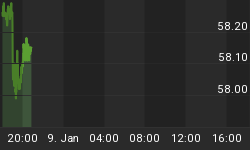One of the big hints that gold stocks will be ready for take-off is when they stop following the broader markets and strictly track gold, particularly if the market falls and gold stocks don't. We now have data showing this has just occurred.
From April 2009 to April 2010, gold stocks mirrored the S&P. The two markets held hands as often as high school sweethearts; there was very little separation between them. While it wasn't always a daily connection, any weekly and especially monthly chart showed them moving in tandem.
Until now.

For the quarterly period of April through June, gold stocks advanced 11%, tracking gold's gain of 10.7%. The S&P, however, lost 14.1%.
We haven't seen this level of separation between gold stocks and the general stock market since the first quarter of 2009. This demonstrates obvious strength in our sector, and is precisely the kind of action that can signal we're gettingcloser to our precious metals investments starting a major leg up.
In the big picture, this data should be considered a short-term indicator. However, it's a refreshing reminder that at some point, it won't matter what the broader markets are doing. In the precious metals bull market of the 1970s, the Barron's Gold Mining Index soared 652%, while the S&P gained only 22% for the entire decade. This means that if you're bearish on the economy, you don't have to be bearish on gold stocks.
Whether this is the beginning of permanent separation or not, the followingchart tells us the stock market, in relation to gold, is going one direction.

At gold's bottom in April 2001, the Dow/Gold ratio (DJIA divided by gold price) was 41.2. It now stands at 7.9 (as of July 2).
When gold peaked in January 1980, the Dow/Gold ratio reached "one," meaning they were both selling for about the same price. To hit that same ratio today, gold will have to go higher and the Dow simultaneously lower. The fundamental reasons gold will rise are far from over, and a second leg down in the broadermarkets seems almost locked in at this point.
In this context, Doug Casey's call for a $5,000 gold price doesn't seem so farfetched. It also coincides with his call for a Greater Depression, an environmentnot exactly suited for higher stock prices. $5,000 gold = 5,000 Dow.
Where do you think they'll meet - three? Eight?
This has obvious implications for your investments. If you're investing for the big picture, you first want to think twice about any conventional stock investment. You might even consider a short position on one of the indices,something without a time limit, such as an inverse ETF.
Second, you should plan on higher gold prices. While pullbacks are inevitable, it does mean that even if you don't own gold yet, it's not too late. In fact, any excuse you have now for not buying gold will seem shallow and meaninglesswhen the dollar begins cratering and so does your standard of living.
Third, don't shy away from gold stocks. Yes, they're still stocks and thus vulnerable, and we're not sure the separation is here to stay, but selling your core holdings would be, in my opinion, a mistake. One of these days gold stocks won't wait around for you to jump back in. And you could find yourself chasing them, a tactical error for the investor looking to maximize profitfrom what we believe will be a once-in-a-generation bull market.
In fact, if you had followed only this strategy since the precious metals bull market began in April 2001, you'd be up 375% in your gold holdings and up 707% in your gold stocks. An investment in the S&P, meanwhile, would've returned you exactly zero.
It's our opinion this trend will continue. Gold stocks could very well get cheaper in the short term, handing us an excellent buying opportunity. Butin the big picture, they're destined for much higher levels.
My advice is to make sure you're on the right side of this trend.
What's a good price on gold, silver, and precious metals stocks? We've charted every summer pullback in prices since the bull market began in 2001, giving us target zones for every asset in our portfolio. Our Summer Buying Guide is an invaluable resource for identifying a good bargain in our industry. And you can access it right now, for $39 per year, with a risk-free 3-month trial. Click here for more.















